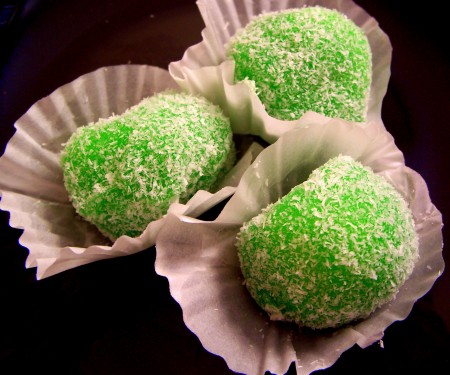
Yet another sticky rice snack that I vaguely remember eating one or twice during the early childhood, and found again in a San Jose sandwich shop more than ten years later. I was excited when I saw these green balls covered in coconut bits.
We Vietnamese call them bánh bao chỉ to distinguish from the meat-filled steamed bun made from wheat flour known to us as bánh bao. Just as bánh bao comes from China, so does bánh bao chỉ. Just as bánh bao are baozi and mantou in Mandarin, mandu in Korean, manju in Japanese, manti in Turkish, and many more, bánh bao chỉ too has its share of names.
The most-result-yielding Google search belongs to loh mai chi, commonly shown as little sticky rice flour dumplings with sweet ground peanut filling. Other variations in Malaysian and Chinese food blogs are snowball, loh mi chi, chi fa bun, muah chee (yeah, these are really cute you’d want to kiss them too)*, noh mi chi, and ma zi. Once again, I feel the need to learn Mandarin. Some say “noh mi” means “sticky rice” in Cantonese, but what does “chi” mean? Others, including the Vietnamese sites, insist that “chỉ” in bánh bao chỉ comes from “mà chỉ”, which is “ma zi”, which is “sesame seed” in Mandarin, which means “mi chi” is “sesame” (recall mi lao – sesame fluff) and we’re left with “noh” being “sticky rice”. It is reasonable enough if we consider that there are four types of fillings for bánh bao chỉ: black sesame, coconut, mung bean, and peanut. But the taste I had from childhood was the salty and sweet ground peanut in a gummy, springy thin layer of white dough coated with flour. Sesame filling must be a new twist.

And so are the vibrant green color and the coconut bits. And the size. Cheap bánh bao chỉ used to be sold on wheels: an old Chinese man peddled around the neighborhood with a glass tank on the back of his worn bicycle, the tank half filled with soft white balls as big as tangerines. Now these balls are about an apricot each, fit snugly in a plastic box and sold for $2 at Kim’s Sandwiches. Not only do they lose the romantic authenticity of a street food, they also taste like soap. The green dough, instead of having pandan flavor, reeks of artificial chemicals. The mung bean paste is sickeningly sweet.
I’ve never been so disappointed with a snack food. Do NOT buy these green balls, no matter how good looking they are. Search online for loh mai chi recipes, or search the streets for old Chinese vendors.
(*) It’s hard to refrain from making the connection between muah chee and the Japanese mochi (daifuku).
The exact origin of mochi is unknown, though it is said to have come from China. The cakes of pounded glutinous rice appear to have become a New Year’s treat during Japan’s Heian period (794-1185). As early as the tenth century, various kinds of mochi were used as imperial offerings at religious ceremonies. A dictionary dating from before 1070 calls the rice cake “mochii.” Around the eighteenth century, people began to call it “mochi.” Various theories explain the name. One is that “mochi” came from the verb “motsu,” “to hold or to have,” signifying that mochi is food given by God. The word “mochizuki” means “full moon.” People of the west and southwest islands called it “muchimi,” meaning “stickiness.”
– from New World Encyclopedia
So I know everybody thinks the entire Far East gets its stuff from China (yeah… no.), but here’s a crazy idea: what if this sticky rice ball with sweet fillings actually originated from Japan, then the Chinese got hold of some, and later passed it down South?
Previously on Sandwich Shop Goodies: bắp hầm (Vietnamese whole kernel grits)
Next on Sandwich Shop Goodies: bánh bò bông (steamed sponge muffin)



mmm..had a bánh bao chỉ yesterday from a little sidewalk vender. sooo gummy and chewy, stuffed with coconut or peanuts. ngon. 3.000 VND.
Jealous. You should post pictures!
ohhh, they look sweet!
As far as I can find, in Mandarin, it is nuò mĭ cí 糯米糍 – nuò mĭ is glutenous rice; cí is sticky rice paste or mochi. There is also this thing about how n and l are pronounced in Cantonese, particularly in Hong Kong. My source for the characters uses noh6 mai5 chi4 (low tone, rising from low to mid, falling from mid to low). It is interesting to me that cí is like cha: rising in Mandarin and falling in Cantonese; e.g., dim sum 飲茶(饮茶) is yĭn chá in Mandarin and yam2 cha4 in Cantonese (according to my sources – I am a native speaker of neither).
Hmm, so nuo mi ci is “sticky rice paste”? That’s very interesting about the n and l in Cantonese. It may have to do with how the Northern Vietnamese people also mix up their n and l. It would also make sense that cí is like cha, if you meant chả, the Vietnamese word for meat paste.